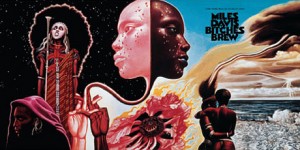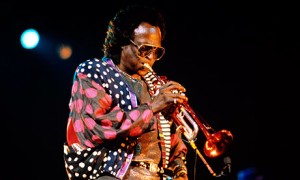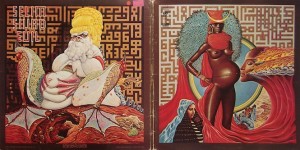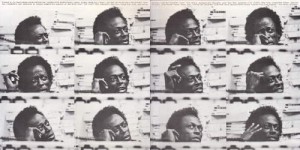Miles Davis is remembered today as one of the most influential figures in the development of jazz in the 20th century. Starting his career with a more conventional cool jazz sound, Davis pushed conventions by experimenting with his playing, compositions, and album instrumentation. I consider the pinnacle of his experimentation to be his 1970 album, Bitches Brew. This album is currently available to be checked out at the St. Olaf Music Library (you need to listen to this if you haven’t already). Unknown to a “Jazz” album at the time, Bitches Brew lacks typical jazz standards, song structures, and melodies in the conventional sense. Instead, Davis gives us a dense and chaotic musical landscapes. The music often sits on 1 chord for minutes, with the musicians improvising wildly over it. Also notable is its bizarre instrumentation of 2 drummers, 2 keyboardists, 2 bass players, 2 percussionists, and a distorted electric guitar. Davis fully embraces this new electric sound, which gives this album a bit of a psychedelic feel.
To me, Bitches Brew is Davis declaring war on all preconceived notions of what “jazz” ought to be. To me, this album is a revolution. I think much of Davis’ rejection of the status quo throughout his career stems from his infamous personality. He had a reputation for his bad temper, a large ego, and general rudeness. To get an idea of what he was like off the stage, I found an interview with Playboy Magazine from 1962. In this interview, Davis talks about his views on other musicians, critics, the creative process, and concerts. Race is a dominating theme throughout the conversation. Given his historical significance and the complex history of race within jazz, I find his comments to be especially impactful.
On prejudices he’s experienced
PLAYBOY: Did you grow up with any white boys?
DAVIS : I didn’t grow up with any, not as friends, to speak of. But I went to school with some. In high school, I was the best in the music class on the trumpet. I knew it and all the rest knew it — but all the contest first prizes went to the boys with blue eyes. It made me so mad I made up my mind to outdo anybody white on my horn. If I hadn’t met that prejudice, I probably wouldn’t have had as much drive in my work. I have thought about that a lot. I have thought that prejudice and curiosity have been responsible for what I have done in music.
On white jazz musicians
PLAYBOY: In your field, music, don’t some Negro jazzmen discriminate against white musicians?
DAVIS : Crow Jim is what they call that. Yeah. It’s a lot of the Negro musicians mad because most of the best-paying jobs go to the white musicians playing what the Negroes created. But I don’t go for this, because I think prejudice one way is just as bad as the other way. I wouldn’t have no other arranger but Gil Evans — we couldn’t be much closer if he was my brother. And I remember one time when I hired Lee Konitz, some colored cats bitched a lot about me hiring an ofay in my band when Negroes didn’t have work. I said if a cat could play like Lee, I would hire him, I didn’t give a damn if he was green and had red breath.
Interviews like these are a fantastic way to get a sense of an artist’s personality. I can see why some might have considered him to be rude or short tempered, but to me, I see an artist with very little care for anything besides his work. Davis was not interested in the superficiality of the entertainment industry. He was a man who simply lived his life and refused to conform. To me, his defiance is admirable.
Refrences
Erenkrantz, Justin. “Miles Davis. A Candid Conversation With the Jazz World’s Premier Iconoclast” Accessed October 30th 2017. http://www.erenkrantz.com/Music/MilesDavisInterview.shtml
Ruhlmann, William. “Miles Davis.” Allmusic. Accessed October 30th 2017. https://www.allmusic.com/artist/miles-davis-mn0000423829/biography




